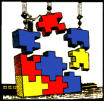Nursing models provide direction for nursing education because models identify current and relevant theory (Rambo, 1984).
Nursing models need to be in harmony with other accepted theories and laws. This gives credence to the model's validity. Imagine if a nursing model proclaimed the world was flat! Models also need to be simply explained, but they need to be applicable to diverse phenomena (Leddy & Pepper, 1993).
Nursing models have become far more prevalent since the 1970s. Prior to this, nursing care was largely dependent on the medical model (Rambo, 1984) and nurses practiced largely by intuition and experience (Leddy & Pepper, 1993). Though intuition and experience are valuable assets, the importance of critical thinking in nursing practice is of utmost importance.
Rambo (1984) describes a nursing model as a dress pattern, providing interrelated pieces that create an original idea. I imagine nursing models as a jigsaw puzzle, comprised of many ideas that allow one to see the big picture best when each idea is viewed in its relation to the other ideas. -Brenda, April 2002

A nursing model is a collection of interrelated concepts that provides direction for nursing practice, research and education.
In nursing practice, nursing models approach the nursing process in a logical, systematic way; the model influences the very data the nurse collects.
In nursing research, nursing models offer a milieu for critical reflection of the hypotheses of the models and the testing of these hypotheses (Rambo, 1984). Validated theories will, in turn, affect nursing practice by offering current and relevant models. This contributes to nursing science. Leddy and Pepper (1993) state that "nursing practice based on science will support the image of nursing as a professional discipline" (p. 144).
Leddy, S. & Pepper, J.M. (1993). Conceptual Bases of Professional Nursing (3rd ed.). Philadelphia: J. B. Lippincott Company.
Rambo, B. (1984). Adaptation Nursing: Assessment & Intervention. Philadelphia: W. B. Saunders Company.
Registered Nurses Association of British Columbia (1990). Nursing Research: From Question to Funding. Vancouver: Registered Nurses Association of British Columbia.